An Introduction to Light in Outdoor Photography
![]()
Photography is all about light. To be more precise, photography is all about the quality of the light. This can be a particular challenge for outdoor/landscape photographers.
Coming from Ireland, where the weather can change by the minute, I understand this challenge only too well. I once came home from a 30-minute shoot soaking wet, freezing cold, and sunburned!
When the light and conditions cooperate, however, the results can be spectacular. It is the quality of light that can turn a photograph from decent to something special. Luck often plays a role in this of course. Often a period of beautiful light may only last a few seconds.
That said, doing some research in advance and making the effort to be in a location at the right time will dramatically increase your chances of finding a quality of light that will bring your photograph up a level or two.
In this tutorial, I’m going to go through the types of light we often find in the early part of the day from the morning blue hour right through to the golden hour.
I have also included a few examples of some of the light we can experience in the middle of the day, a time we often don’t think of as being particularly interesting when it comes to outdoor photography.
Morning Blue Hour
We most often associate blue hour with the evening but we often forget that there is a morning blue hour too! This is the period when the darkness of the night is beginning to lift and the sky takes on a deep blue color just before dawn.
Using the word “hour” is a bit of a misnomer. Blue hour can last from a few minutes to several hours. Depending on the time of year and your latitude, the morning blue hour can be anything from about half an hour to several hours before sunrise.
Blue hour is by far the best time to capture night photos, especially in cities. There is just enough ambient light to balance the city illuminations with the darkness of the sky.
When the sky is black, there is often too much contrast between the black of the sky leading to exposure issues. The deep navy tones of the blue hour sky also tend to provide a more attractive background to the foreground scene.
Funnily enough, most of my Dublin nighttime photos were actually taken in the morning!
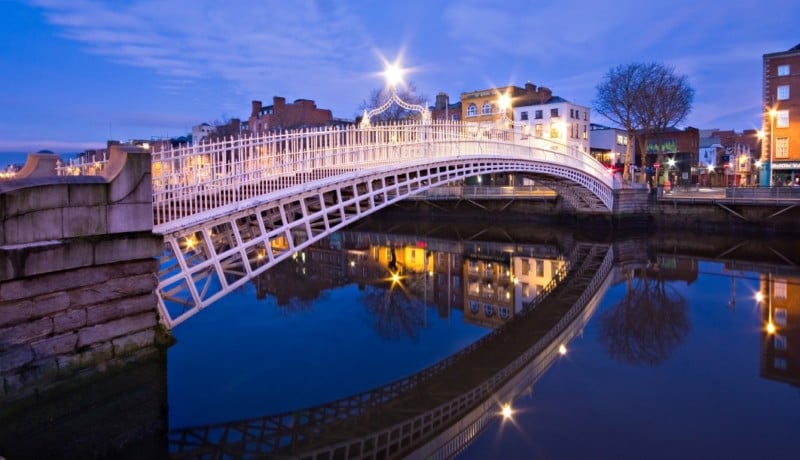
The Ha’penny Bridge is one of the most recognizable landmarks in my home city of Dublin. I love photographing cities during the morning blue hour. Often, it feels like I have the whole place to myself at this time. In these photos, the deep shade of blue in the sky is very apparent. See how more attractive this is than a pure black sky.
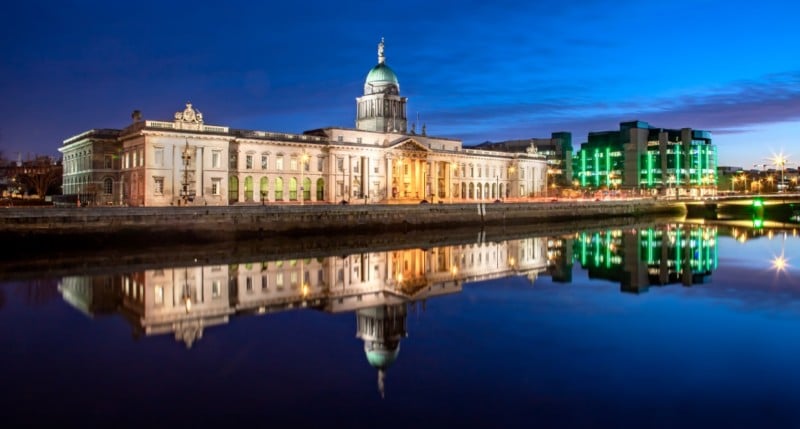
The Customs House is another well-known building in Dublin. Many people are surprised when I tell them this photo was actually taken in the morning! You can see the sky beginning to brighten in the right of the frame as the sun (although still below the horizon) begins to light the sky.
The next photograph was taken on St. Mark’s Square in Venice during the morning blue hour.
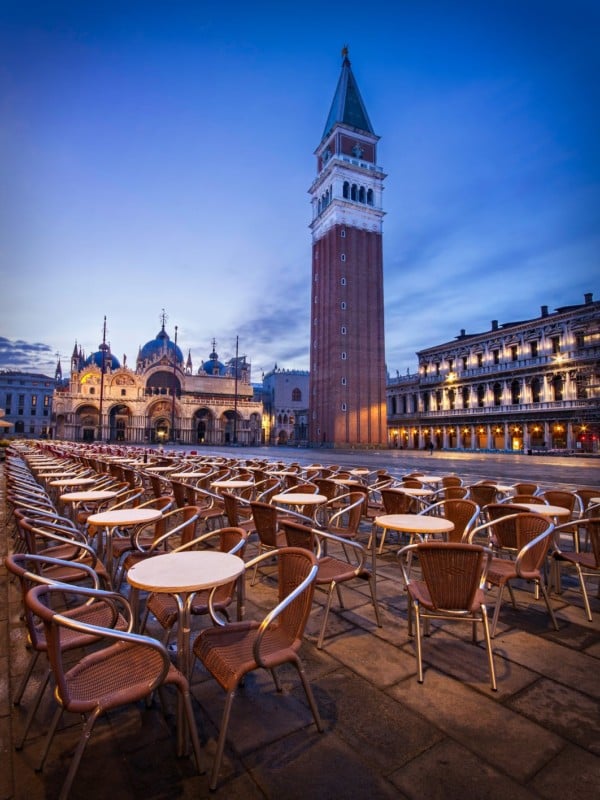
St Mark’s Square is usually packed with tourists and trinket sellers all day long. At 6 am, however, during the morning blue hour, I had the place to myself. The only other people on the piazza were another photographer and a man gently sweeping the ground with an old-fashioned broom.
As my wife can confirm, I am not a morning person but it really is worth the effort to drag oneself from the coziness of a warm bed to visit a famous location before the crowds arrive.
I tried to visit the basilica later in the day with my wife and two-year-old son later on that day. It turns out toddlers don’t really like dark medieval churches all that much. He didn’t really appreciate the Byzantine art and Venetian architecture as much as I’d hoped. I don’t think such screams had been heard in Venice since Napoleon attacked the area over 200 years ago. He much preferred chasing pigeons on St. Mark’s Square (my son, not Napoleon).
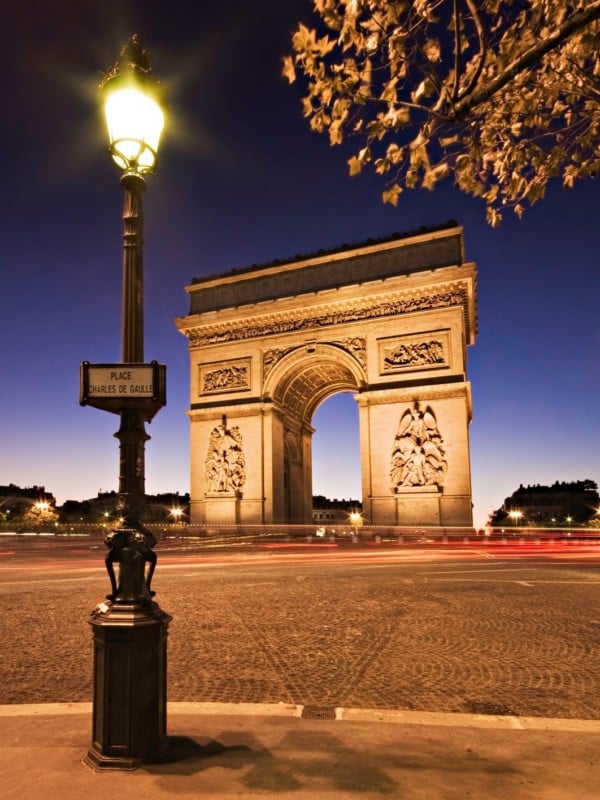
The final morning blue hour photograph in this series was taken on an autumn morning at the Arc de Triomphe in Paris. Thankfully the illuminations were still lighting up this impressive monument at this time. This is not always the case in the morning.
I was actually very lucky to get this shot. I had to wait about fifteen minutes for an airport bus that was blocking this view to move out of the way. Being patient is a very important part of successful photography.
The Arc de Triomphe was of course commissioned by our pigeon chasing friend Napoleon to celebrate his many military victories. He never got to see his vision completed however as the arch was not completed until 1836, fifteen years after his death.
There was actually a plan (before Napoleon came along) to erect a giant elephant in this spot. How different my photograph would have been then.
Dawn and Sunrise
Dawn is a great time for natural landscapes. The period just before sunrise is one of my favorite times to take photos. Often at this time, the light has a slightly more subtle almost pastel feel than the time just after sunset for example. As the day gradually moves from blue hour to dawn, the lighting conditions begin to change dramatically.
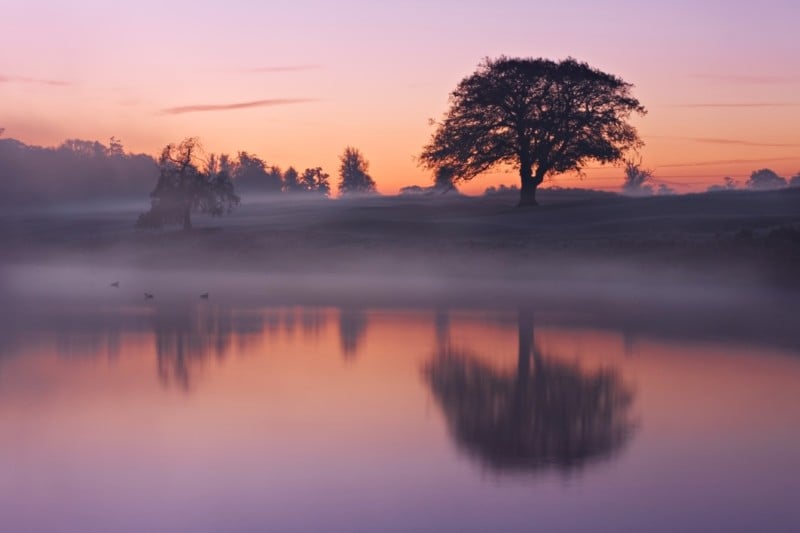
This photo was taken near my former university town of Maynooth in County Kildare. As the sunrise approaches, the sky often contains some really beautiful colors. You can see the soft orange glow of the soon to rise sun merge with the soft pink tones of the dawn sky.
The ever brightening sky also allowed me to capture a silhouette of the tree on the river bank. Dawn is an excellent time for photographing silhouettes.
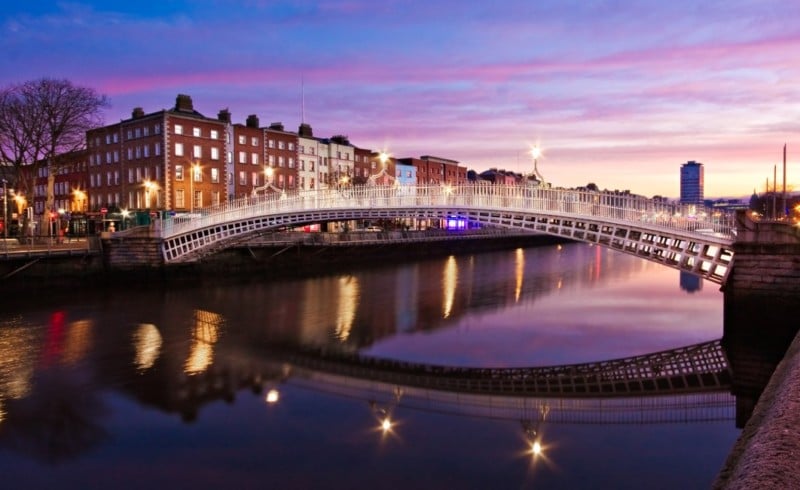
This photo of the Ha’penny Bridge was taken about twenty minutes later than the morning blue hour example in the previous tutorial. It was taken from the opposite side of the bridge this time.
Although the sun is still just below the horizon in this shot, its light has illuminated the clouds above in an attractive pink hue. A little bit of scattered cloud at this time is often preferable as the light from the sun bounces off the underside of these leading to some beautiful colors.
What a difference twenty minutes makes! As I said in the introduction, interesting light may only last a few minutes or even seconds in some cases.
This scene will look completely different later with the harsher light of the midday sun….. or under heavy rain as it’s in Ireland! It really is worth it to get up early to capture a scene in such interesting and attractive light.
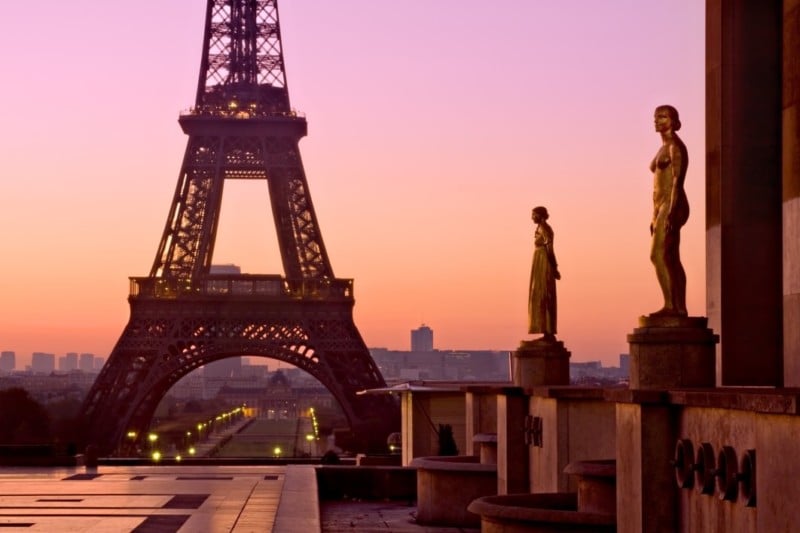
As with St. Mark’s Square in Venice, the area I took this photo from is usually crowded with hordes of tourists. At 6 am, however, I had the place to myself with the exception of a very drunk Parisian who would randomly wander into the frame every so often.
Again, you can see how capturing silhouettes against the colorful sky is often an option when taking photographs at dawn.
As I was leaving, my drunken friend was chatting up one of the golden statues. I hope he was successful. I was certainly rooting for him.
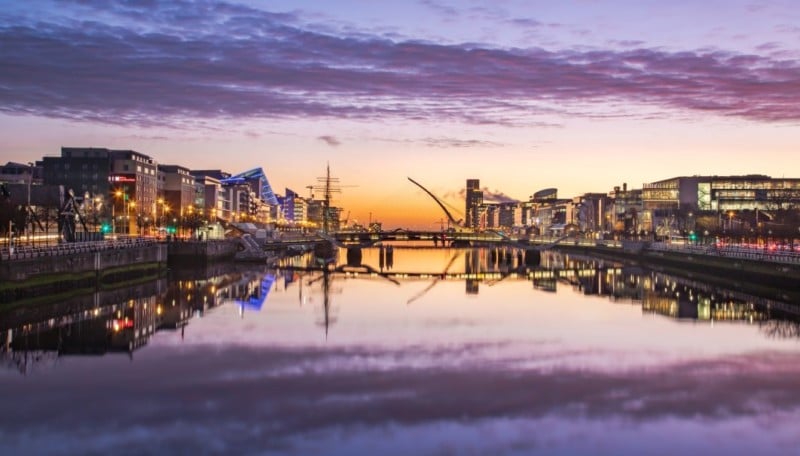
Shooting directly towards the area where the sun will soon rise can produce dramatic results. In this photo of the Dublin Docklands, I have pointed the camera towards the mouth of the River Liffey to the east. You can see the orange glow of the sun on the horizon which contrasts really beautifully with the purple hues in the early morning sky. These are two colors that can be very striking when used together.
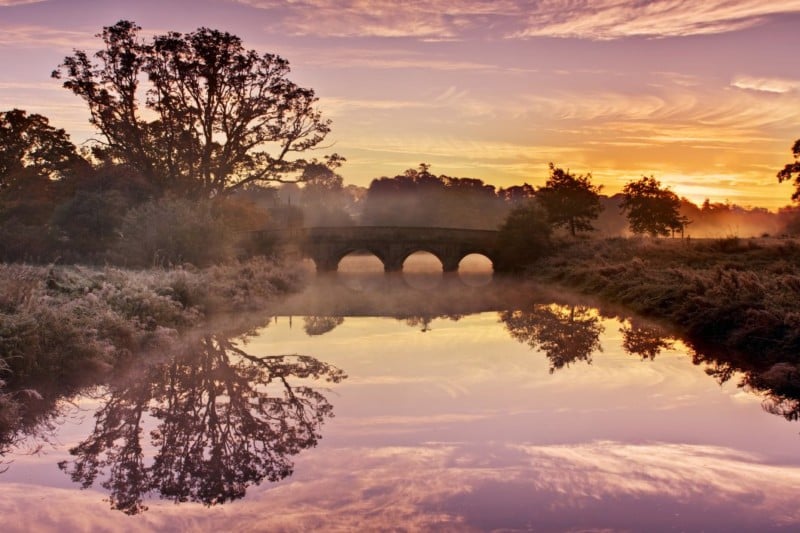
Taking a photograph just at the moment the sun is about to emerge from below the horizon can produce stunning results if the conditions are just right. In the photograph above, this light lasted only a few seconds. I was also lucky that the windless conditions created beautiful reflections.
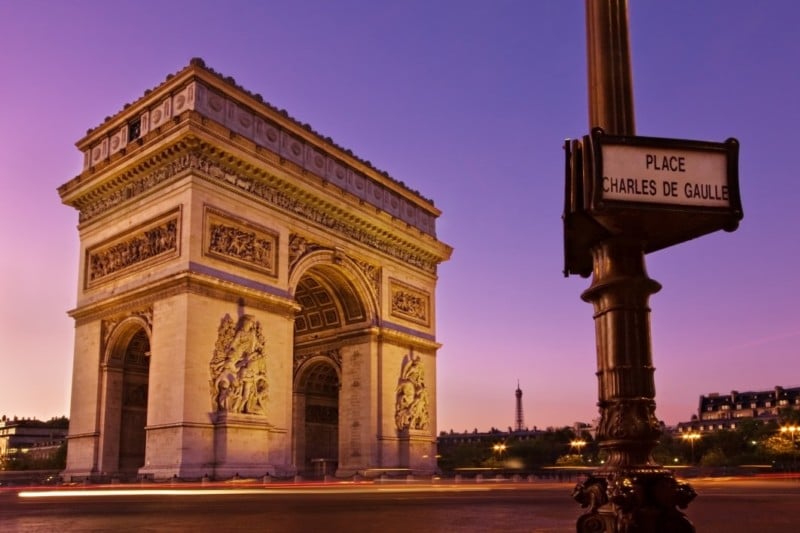
The photograph above was taken about 30 minutes after the blue hour one when the soft dawn light had taken over the scene.
Again, I was very lucky to get this shot at all. The illuminations on the monument switched off only a few seconds after I took this photo.
Morning Golden Hour
Most novice photographers know about the virtues of shooting at golden hour and with good reason too. The light at this time can help produce stunning results.
The golden hour refers to the period just after the sun rises or just before it sets. We are going to focus on the photographic possibilities during the morning golden hour.
I’m sure you’ve noticed how the light of the early morning sunrise and its evening sunset counterpart often bathe buildings or a landscape scene in a beautiful golden glow.
This golden warm tone is due to the fact that the sun is lower in the sky in the morning and evening. This means the light passes through more of the atmosphere which scatters the bluer cooler light in the color spectrum. This leaves us with the warmer red, orange, and yellow tones.
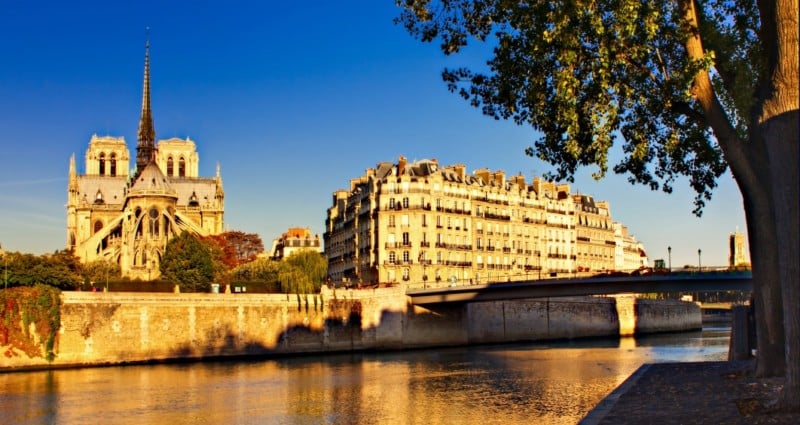
I took this photo from behind Notre Dame Cathedral in Paris just after sunrise. Notice how the early morning sun bathes the whole scene in a wonderful golden light. As the day goes on and the sun climbs higher, the light loses this warm-toned quality and becomes harsher and cooler.
In the tutorial on color temperature and white balance, we saw a comparison of the façade of Notre Dame Cathedral taken during the daytime and during golden hour. The difference in the tones and overall feel of the photograph was very striking. In that tutorial, we saw how different light sources can affect the white balance and color tones in a scene. We learned that often it is desirable to keep these tones (especially warm tones) rather than trying to correct them.
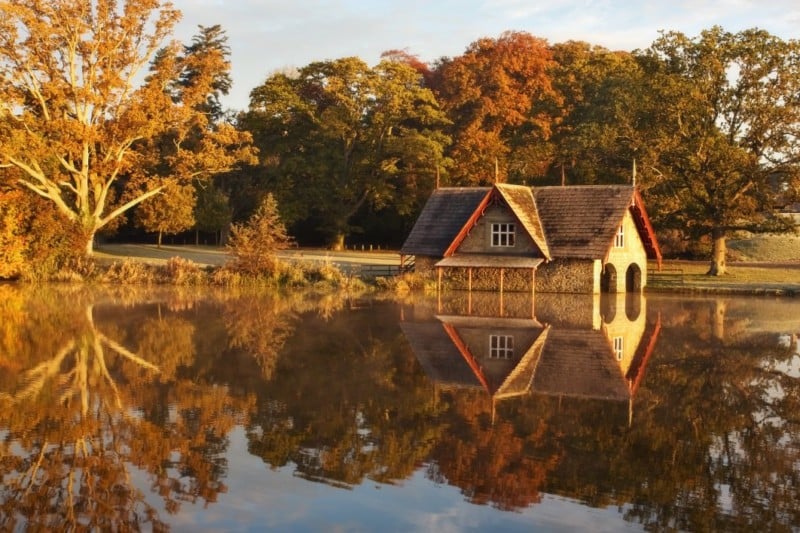
Autumn/Fall is a particularly good time for golden hour landscape photography. The golden light really makes the already warm tones in the scene really glow. Look at the light on side of the boathouse. This shot was taken a few seconds after the sun had risen when the light was at its warmest.
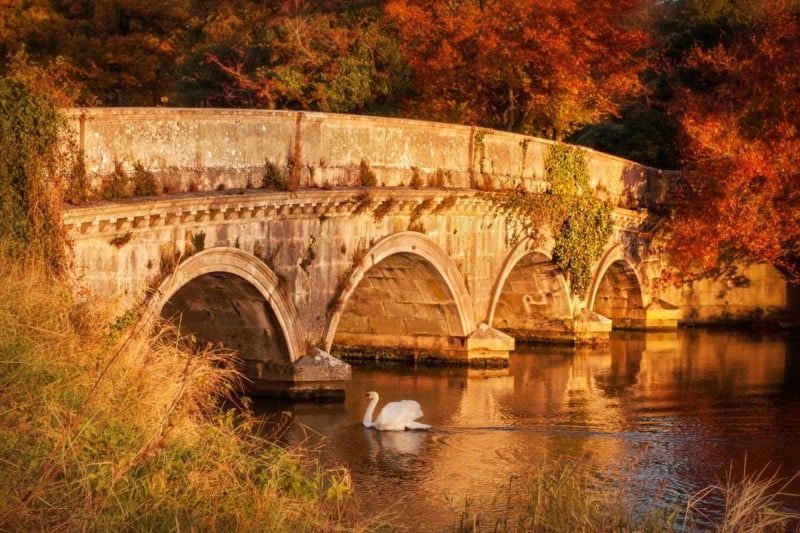
This photo was taken at the same location as the last one. The warm early morning light is really evident on the bridge. I was very lucky that morning as one of the local swans would obligingly drift into frame now and then. I named him Henry. He was very tasty.
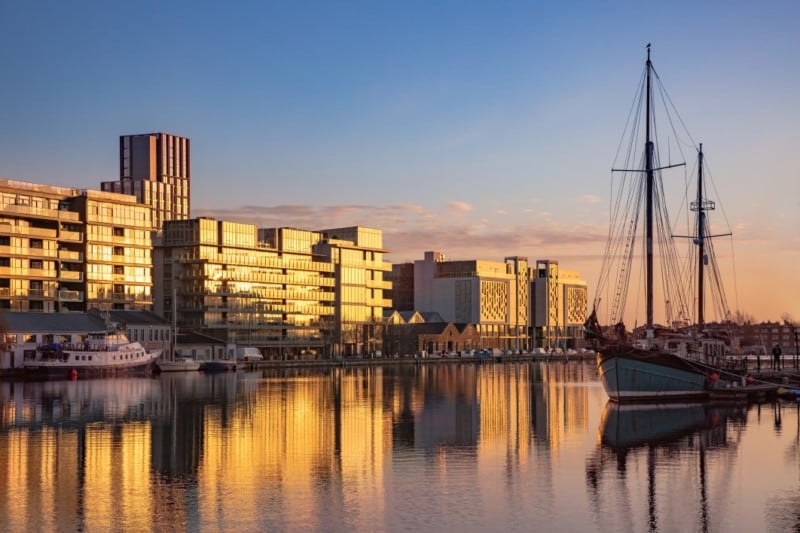
The final morning golden hour photos in this series all come from Dublin. In the photo above, the buildings along Grand Canal Dock are bathed in the early morning golden light.
The next two photos were taken on the same morning a few minutes later at the nearby Samuel Beckett Bridge.
In both images, the golden light on the buildings is combined with some beautiful colors in the sky created by the warm-toned light bouncing off the underside of the clouds.
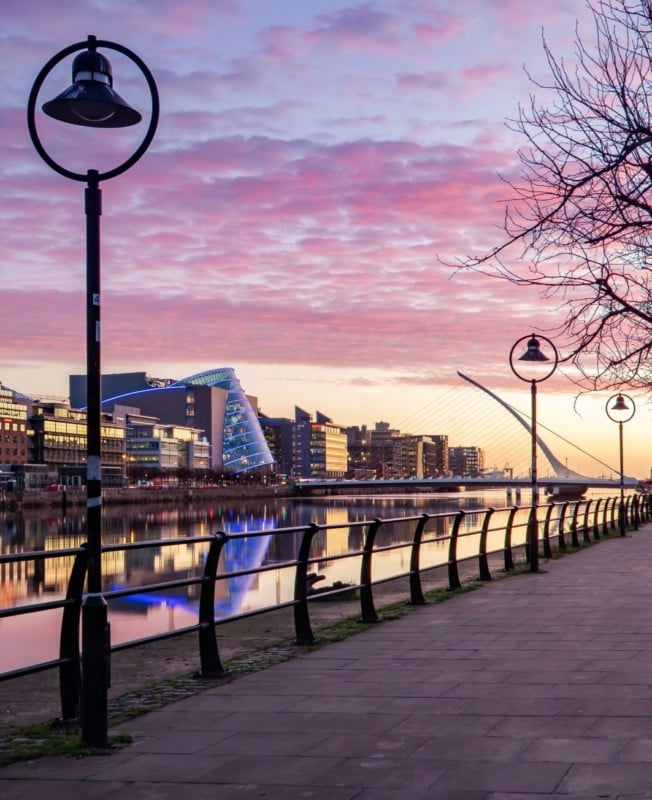
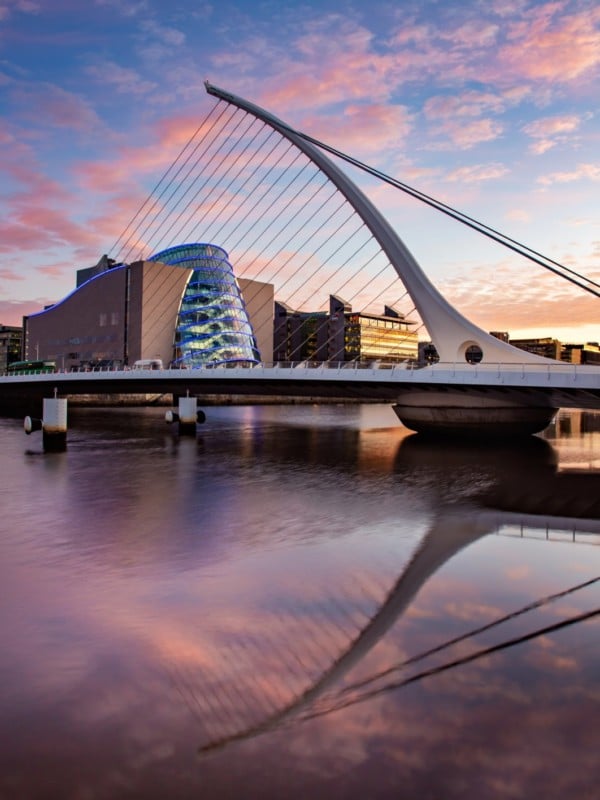
Daytime – Sunny Weather
I take the vast majority of my photographs in the morning and evening when the light is at its most interesting. The midday light from the high sun tends to be harsher and cooler than the softer side lighting of the morning and evening. Generally speaking, it tends not to be the best time for outdoor photography.
This is not to say that there are no opportunities to take excellent photographs during the day. Over the years, I’ve discovered that there are a number of situations where strong daytime sunlight can be used effectively.
Black and White
Strong sunlight tends to highlight the tones and textures in the scenes as well as create strong shadows. For this reason, high contrast black and white photography is often a suitable option on sunny days especially on sunny days when there are plenty of scattered clouds in the sky. Take a look at these next two photos I took on my phone camera on a chilly January morning.
![]()
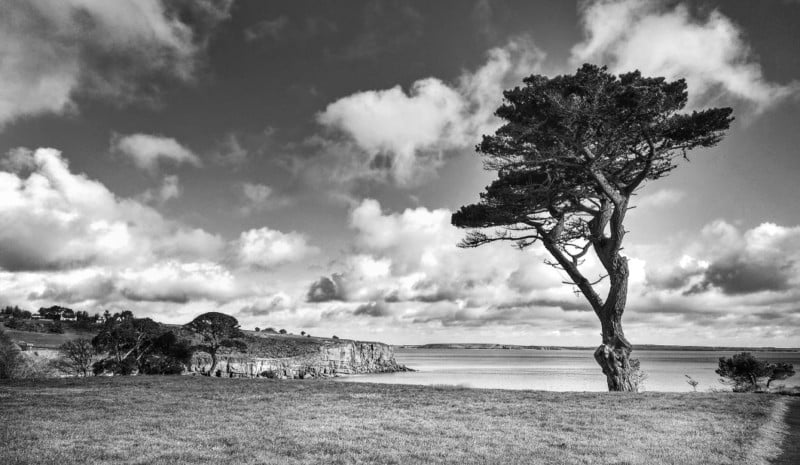
This scene was photographed on a bright sunny day along the Copper Coast in County Waterford.
The location was interesting and the composition is solid with the arrangement roughly following the rule of thirds. The color shot is lacking something though. The light is very harsh and is quite cool in terms of color temperature.
Look what happens when we convert the photograph to black and white, however. Suddenly the contrast of the clouds against the sky and the different tones throughout the image become much more apparent and striking. The second photograph definitely has more visual impact. There is a more “dramatic” feel to the shot.
This is a good example of how shooting with black and white photographs in mind can be very effective in strong daytime light. The next pages contain a few more examples of black and white photographs captured in harsh sunlight.
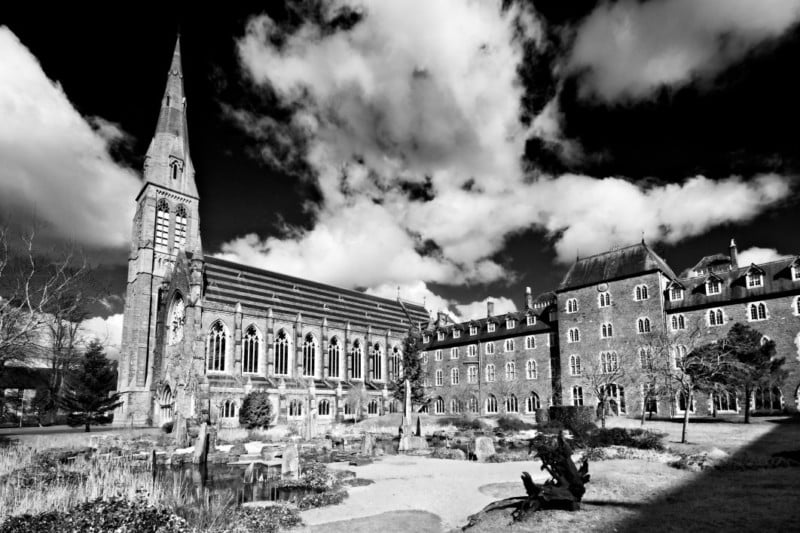
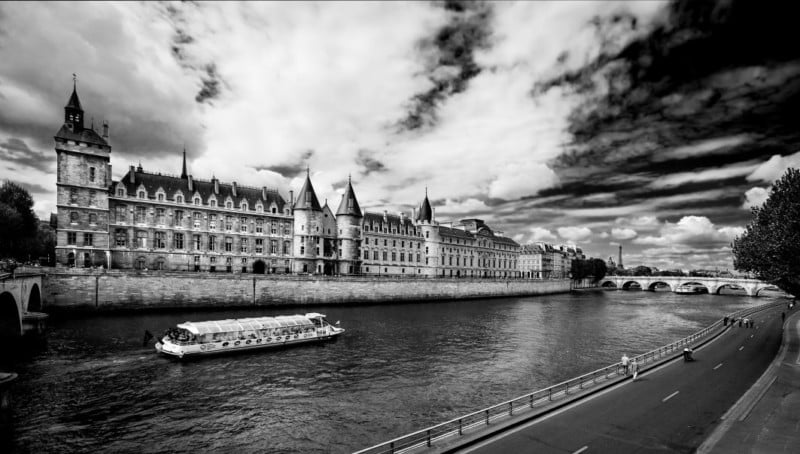
Long Exposures
I find that sunny days with plenty of scattered clouds are an excellent opportunity to try some long-exposure photography. The photograph below was taken using a 10-stop neutral density filter. This allowed me to slow the shutter speed down to a very long 55 seconds, something that would normally be impossible in daytime.
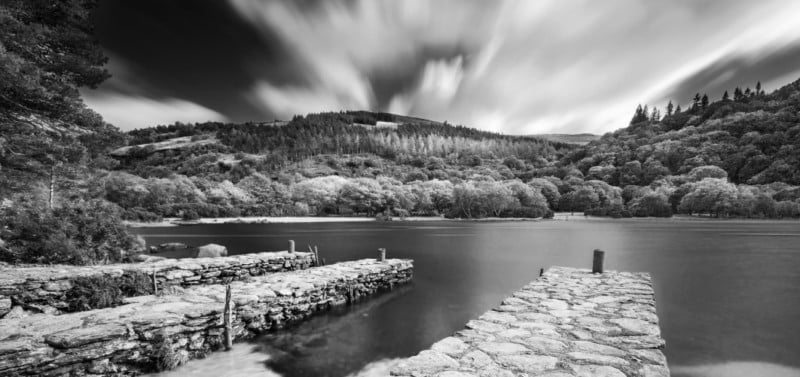
The long exposure time of almost a minute allowed me to capture the motion blur of the clouds as they moved across the sky. Combining this with a high contrast black and white conversion creates a photo with plenty of impact.
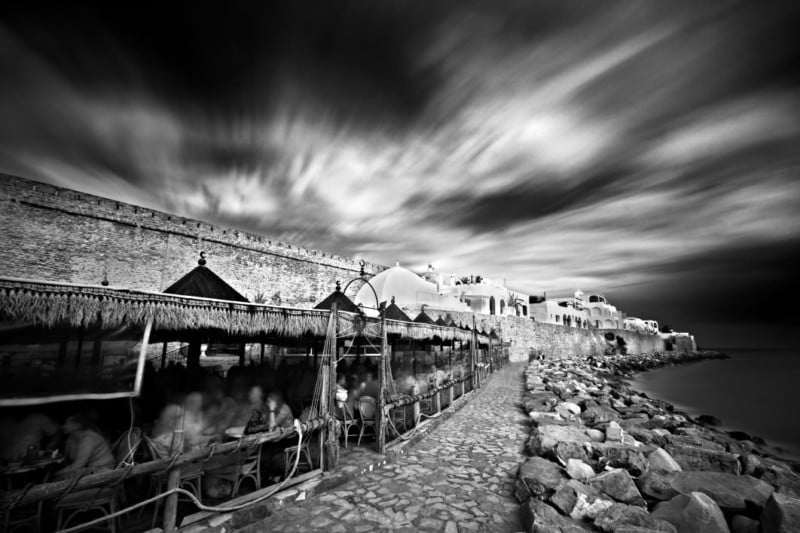
In this photograph, I used an infrared filter. Not only did this allow me to use a slow shutter speed of 22 seconds leading to plenty of motion blur in the clouds. Infra-red filters create images with a completely red hue in the color version. This can then be used to create a high contrast black and white version of the photograph.
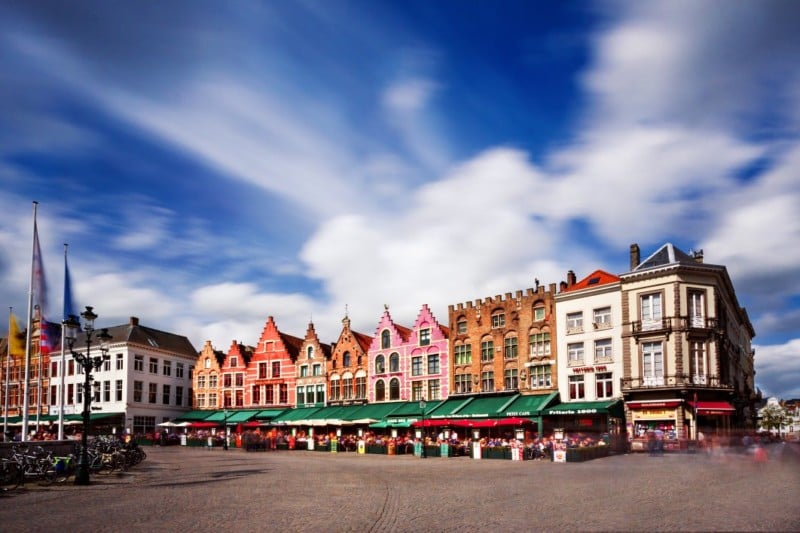
You are of course not completely limited to black and white photography in the strong midday sun. In the photo above, I again used a 10 stop neutral density filter to capture the motion blur of the clouds with a long exposure. It also has the effect of making most of the people in the scene disappear. Anybody moving the frame did not show up in the photograph. Bold colors like those on the beautiful Flemish-style buildings in the scene are accentuated by strong sunlight.
Bold Colors
As I have just said, subjects with bold colors can look very striking when photographed in the strong direct light of the daytime.
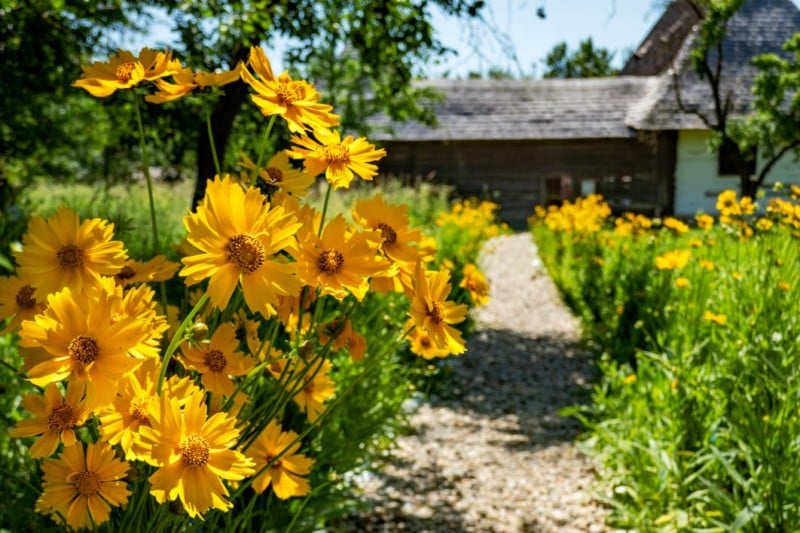
The strong midday sun has really made the yellow flowers stand out in this photograph taken outside a Romanian farmhouse. Getting the exposure settings right can be tricky when there is a mix of strong light and deep shadows in a scene.
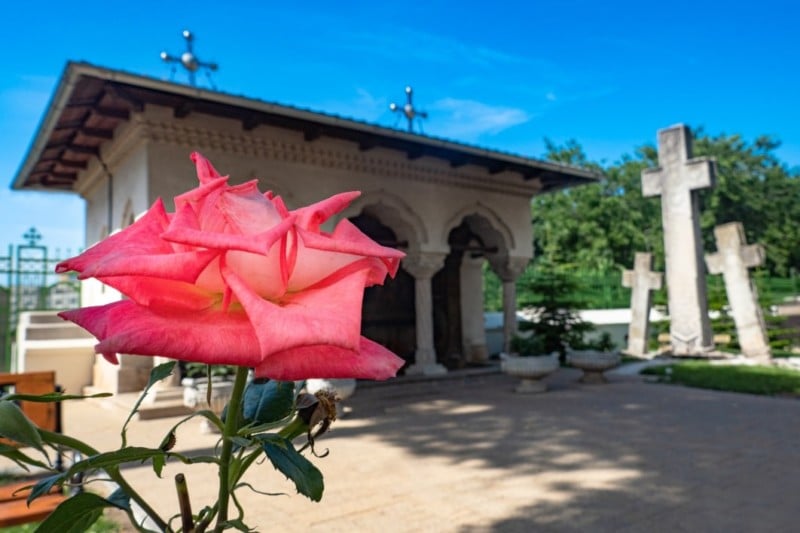
As in the last photograph, we can see that the bold colors of flowers are particularly vibrant when photographed in strong sunlight. It was in a church very close to this spot that I received a smack to the head by a disgruntled worshipper. Later that evening I almost got arrested for photographing the Romanian National Parliament building. I don’t think they’ll ever let me back into their country.
Countries in Southern Europe with plenty of bright whitewashed buildings with splashes of color are almost always bathed in bright light.
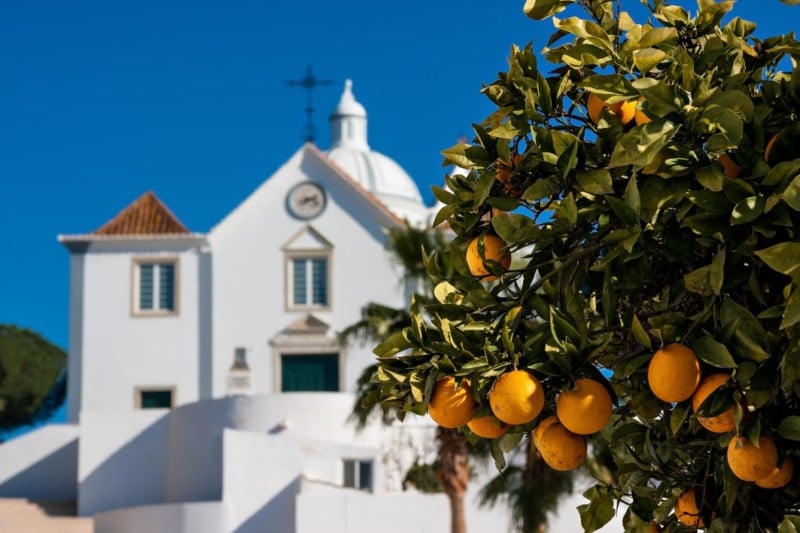
I like how the color of the oranges contrasts with the bright white of the church and the deep blue sky in this little village in the Algarve.
Narrow streets are good candidates for daytime photography as the high sun illuminates the street which is usually in deep shadow.
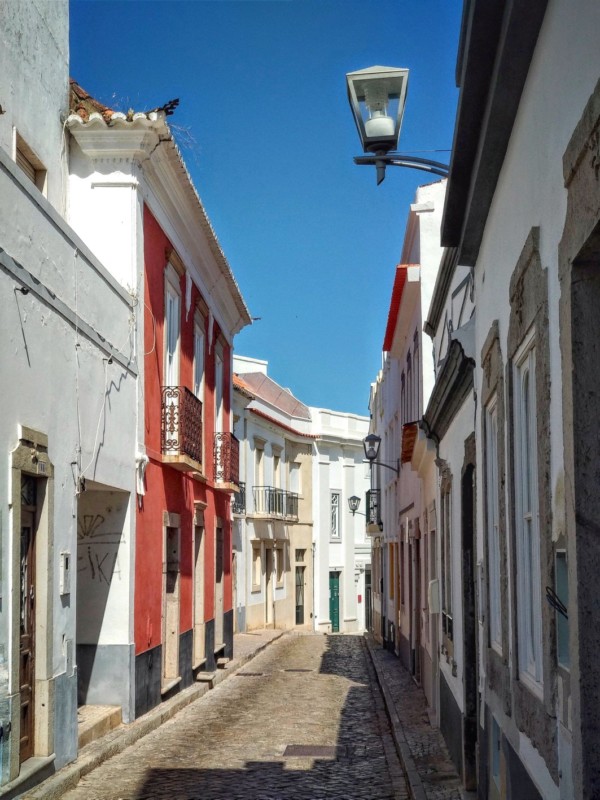
Portugal also contains buildings with some really beautiful colors. Again, the strong daytime sunlight makes these colors pop and brings out the textures on the surfaces.
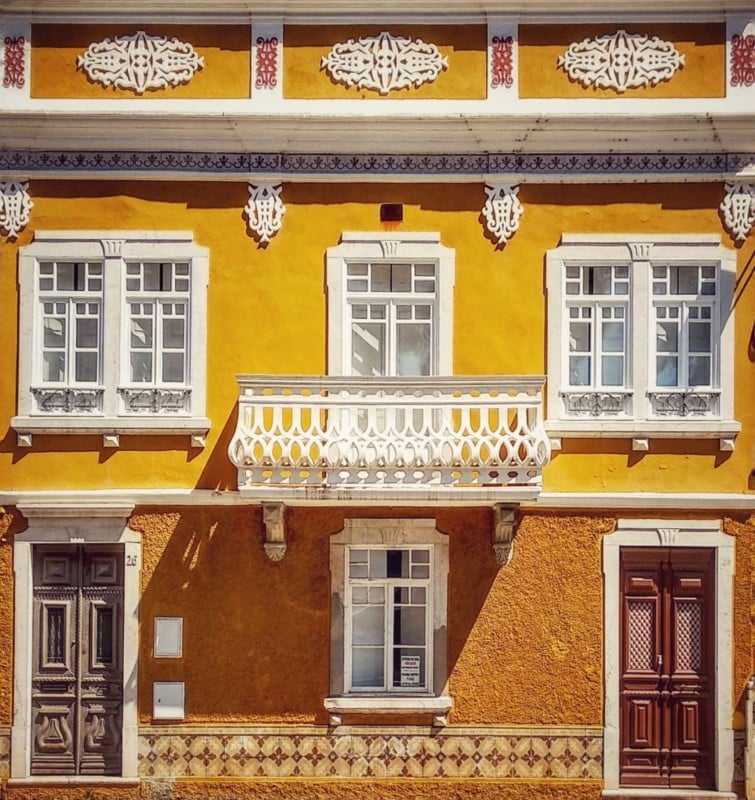
I noticed this beautiful ochre-colored building in Tavira while out for a walk and couldn’t resist taking a photo of it on my phone camera.
Dappled Light
Searching for dappled light on a sunny day can lead to some very interesting photographic opportunities. Dappled light refers to that spotted light that typically shines through gaps in a tree canopy. This softens the harshness of the light.
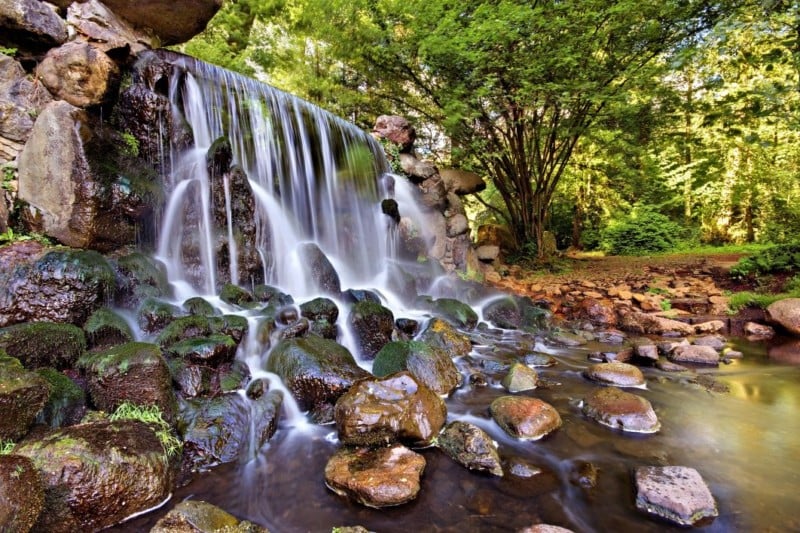
The dappled light in this wooded area of a park in the Dutch city of Arnhem made for an attractive photograph of this waterfall.

The dappled light from the overhanging leaves of a tree has created an interesting mix of light and shadow on this little square in Tavira.
A lot of the photos I took in Tavira were actually taken on my phone camera. It is often said that the best camera is the one you have with you.
It’s actually quite a pleasant experience to go for a leisurely stroll without all the heavy camera equipment. I have since bought a compact camera that I keep on me almost all the time in case an interesting photographic opportunity crops up. This camera has a one-inch sensor that is significantly bigger than the tiny sensor in a phone which itself is capable of producing decent results. This means I can take high-quality photos without being weighed down by lots of gear.
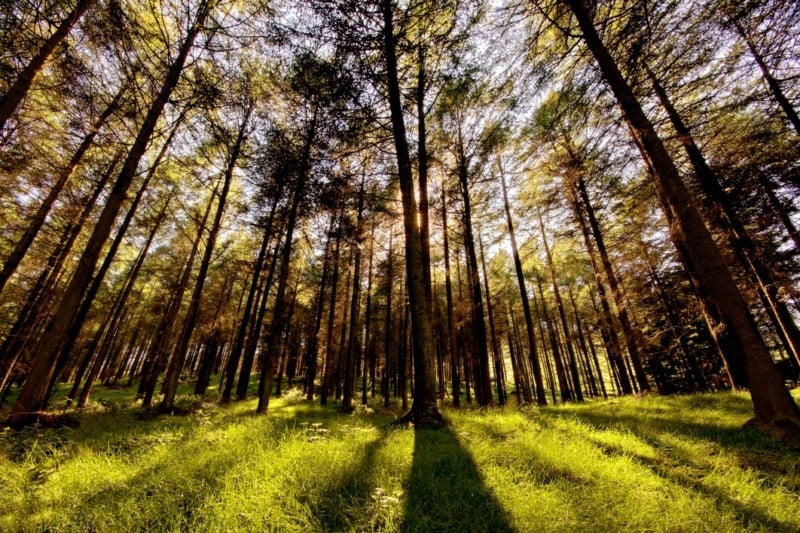
The dappled light in this forest led to an interesting photograph with plenty of contrast between the light and shadow in the scene.
Shooting Architecture in Strong Light
Sunny days with a completely clear blue sky are rarely conducive to capturing the more artistic style photos. Aside from the harsh light, the cloudless sky can seem uninteresting and devoid of drama. Such days, however, can be very suitable for architecture photography.
In this case, it is the form, shapes, angles, and colors that are the most important elements of the shot. A clear blue sky does not distract from the main subject of the photo.
As we have already seen, the strong daytime light accentuates sharp detail, colors, and textures in the architecture being photographed.
The photographs of my local council building on the next page were taken for use in brochures and online. They are not meant to be framed as art but rather to show off the architectural features, textures, and shapes of the building being photographed.
![]()
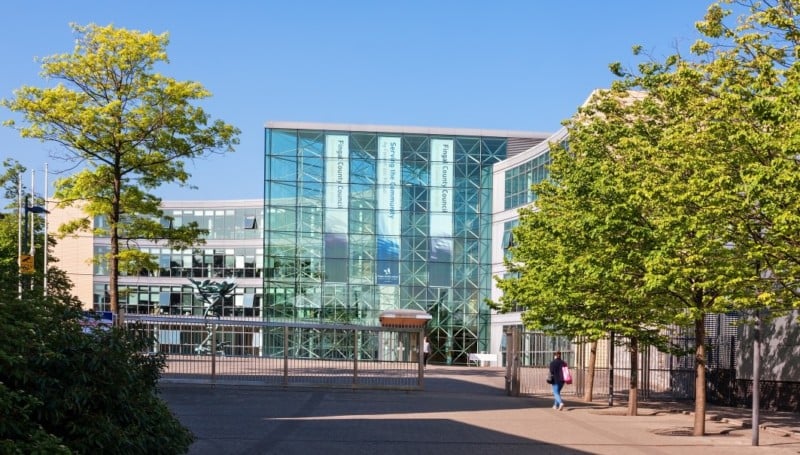
Notice how the shadows in the first photo lead the eye to the buildings. In the second photograph, the trees act as a framing device for the building. There is also a juxtaposition between the natural trees and the manmade building in the second image. The person walking to the right of the frame along provides human interest and a sense of scale.
![]()
I quite like the “DNA” sculpture that rises from the water. You will notice that this photograph of the building contains plenty of strong diagonals and triangles. We learned earlier that this adds a sense of “dynamic tension” to the scene.
Avoiding the Strong Light
Finding dappled light is a good way of reducing the harshness of the midday sun. Another method is to avoid it altogether.
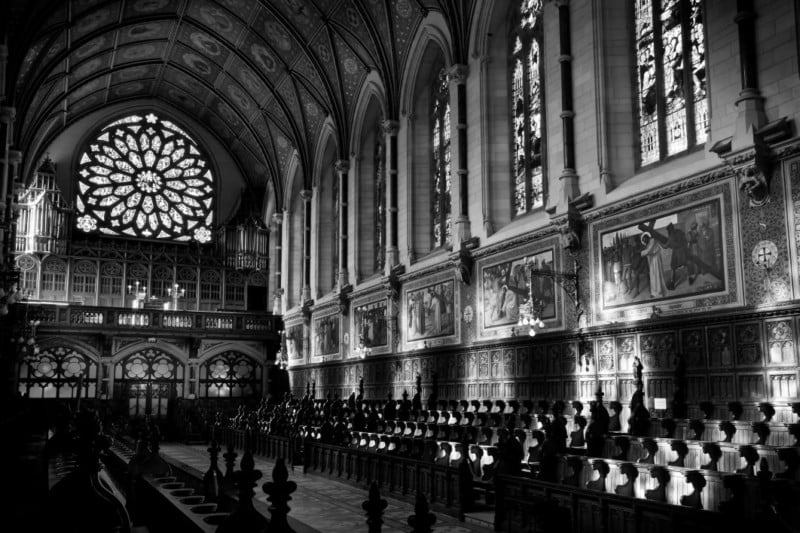
The strong sunlight streaming through the windows of this church has created an interesting contrast between the light and shadow in the scene. Churches provide excellent subjects for indoor photography when the light outside is too strong or uninteresting.
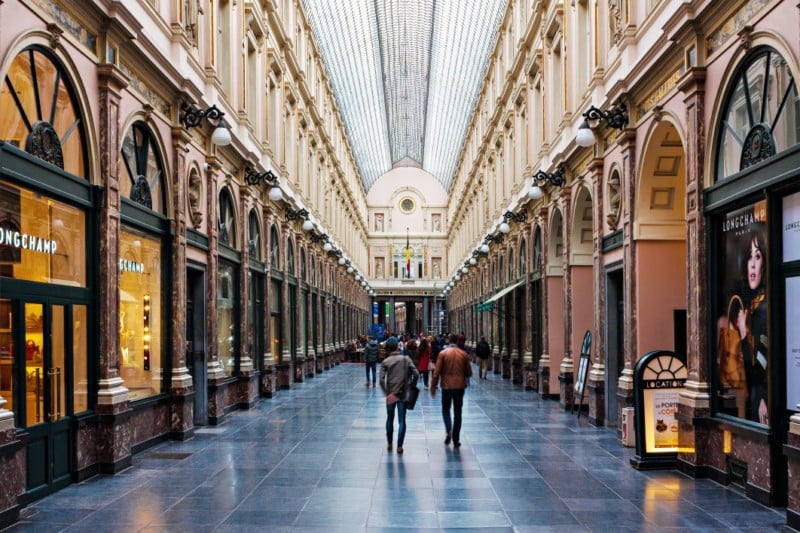
Ornate covered galleries like this one in Brussels are fantastic locations for daytime photography or if it’s pouring rain as was the case when I took this shot. Paris also has some superb examples of these covered galleries.
The whole scene looks wonderfully grand and genteel. It has the effect of transporting one back to the nineteenth century.
I feel like I should be wearing a top hat while sporting a magnificent handlebar mustache and monocle as I stroll along with my carved wooden cane. I don’t know how such a look would be perceived back in Dublin. Although with all the hipsters around now, I might get away with it.
The photograph on the next page was taken in Bucharest. You may have noticed that a lot of major cities and towns seem to have at least one street that is covered by a canopy of umbrellas suspended above it.
These streets can make for very interesting photography locations in the daytime. The umbrellas have the effect of softening the light in the scene as well as providing a vibrant splash of color or multiple colors as in the next photograph.
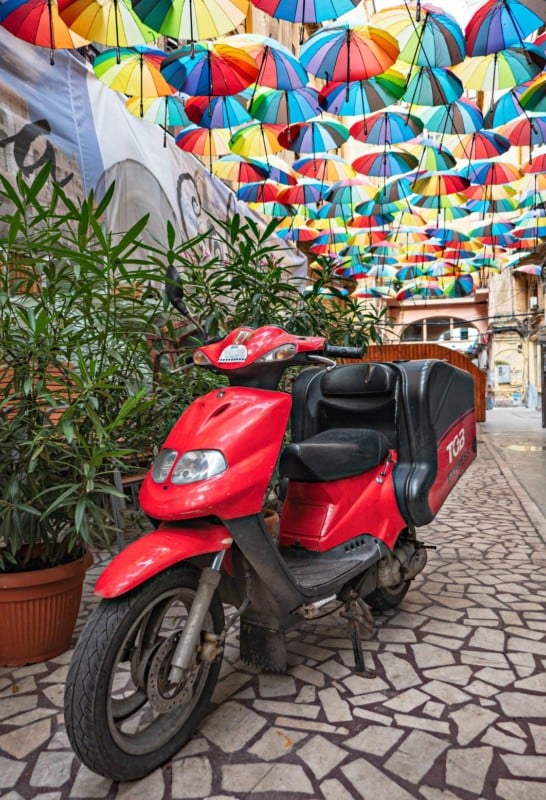
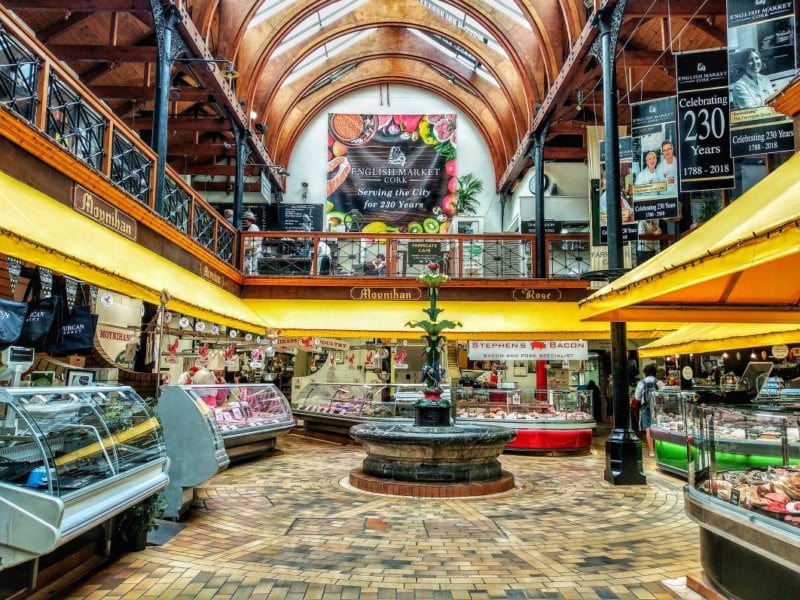
Markets can be excellent locations for indoor photography. There is always plenty of activity to capture. Many of these markets take place in interesting buildings such as the English Market in Cork City above. I really liked the wooden beams in the roof as well as the interesting patterns in the paving. This is another shot I took on my phone camera while out for a walk.
Archways through buildings are another good location for avoiding strong light.
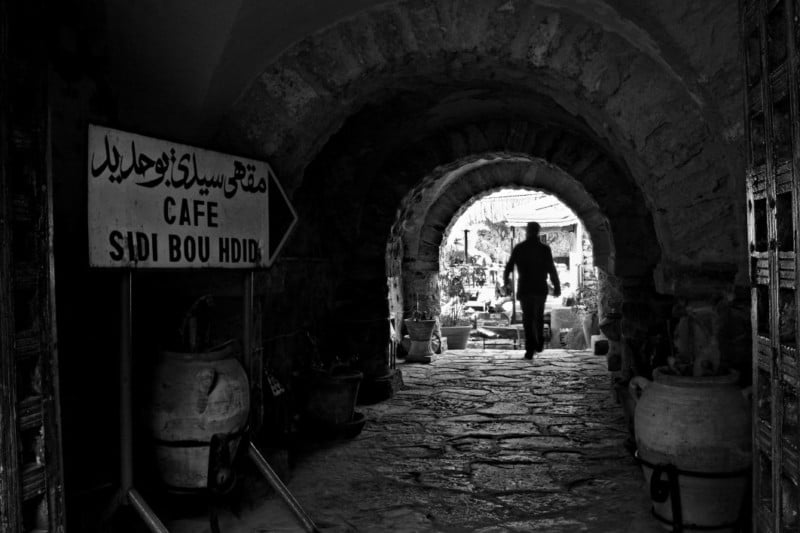
The entrance to the souk of Hammamet provided me with an opportunity to get out of the strong North African midday sun. Being Irish; this was probably a good idea anyway. After ten minutes in the sun, I look like a beetroot with a fever.
In the next photograph, I captured a street musician playing the saxophone in the archway that leads into the Temple Bar district of Dublin.
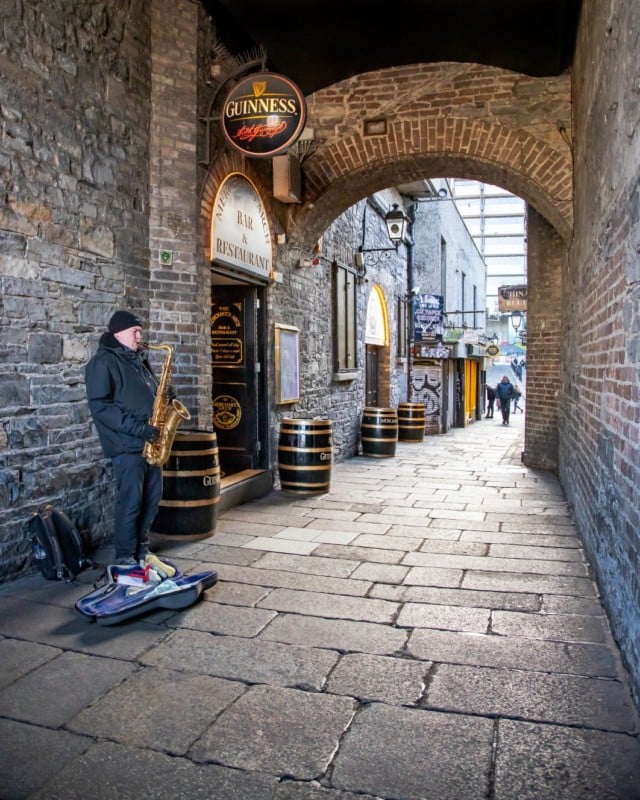
Daytime – Overcast Weather
A lot of outdoor photographers often write off cloudy overcast days. On a cloudy day, the light tends to be very flat and not particularly interesting or dramatic. There was a time when I rarely took out my camera on days like this.
I’ve come to realize however that there are in fact certain types of photography that are very well suited to overcast conditions. The flat light of a cloudy sky can act as a giant softbox creating a soft even light that makes setting exposure easy and is perfect for a range of subjects.
Capturing Details
You can use these days to focus on details rather than vast sweeping landscapes. The even light makes it easier to capture small details in flowers and plants for example without worrying about harsh shadows obscuring part of the subject. The next two photographs were taken in gardens on an overcast day.
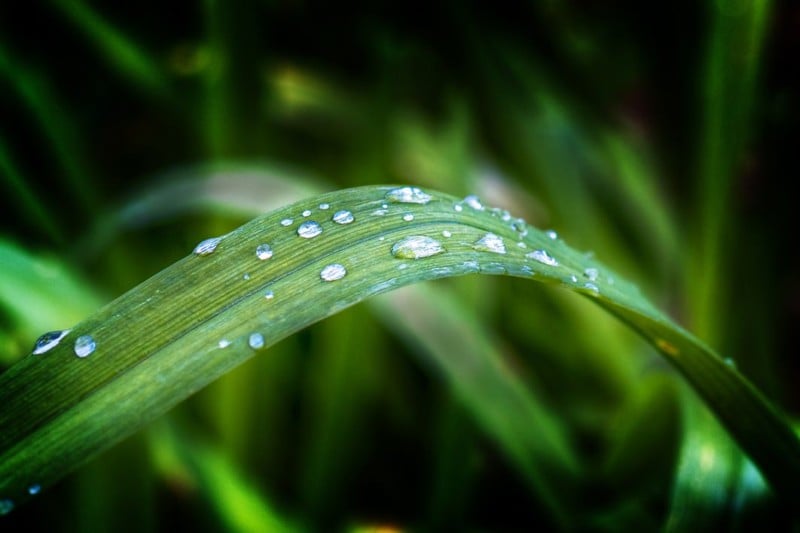
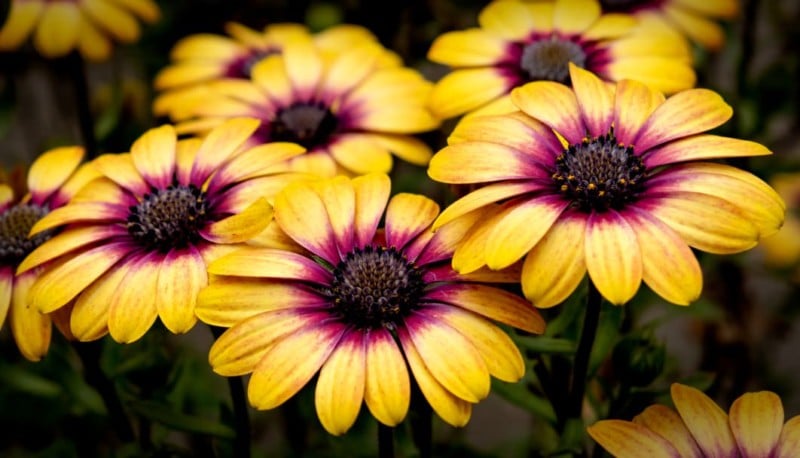
Street Photography
Capturing detail at street level is another great option on a cloudy day. The even light makes setting the exposure easy. You set it once and you don’t really have to worry about it again unless the light changes dramatically. This leaves you free to concentrate on finding interesting street scenes to capture such as these two women sitting having a chat by a bridge in Venice.
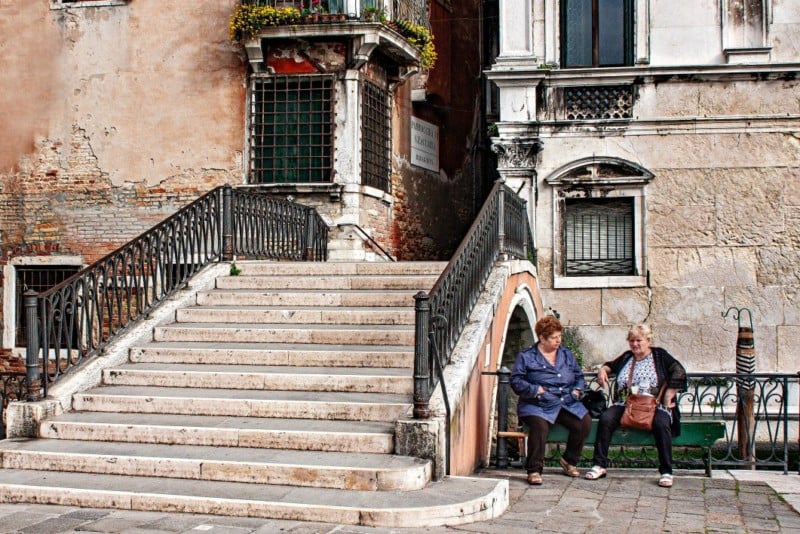
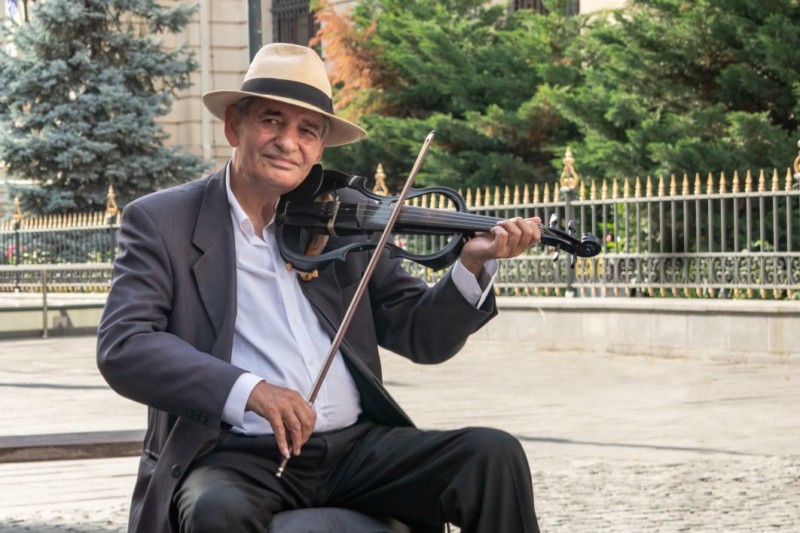
Cloudy days create the perfect conditions for shooting environmental street portraits like this one of a violinist in Bucharest. The cloud-filtered light is better than any studio lighting!
Overcast days are great for capturing the details of building facades. The sky was not particularly interesting the day I took this next shot in Venice so I just left it out completely and concentrated on this rustic house façade in a tiny courtyard.
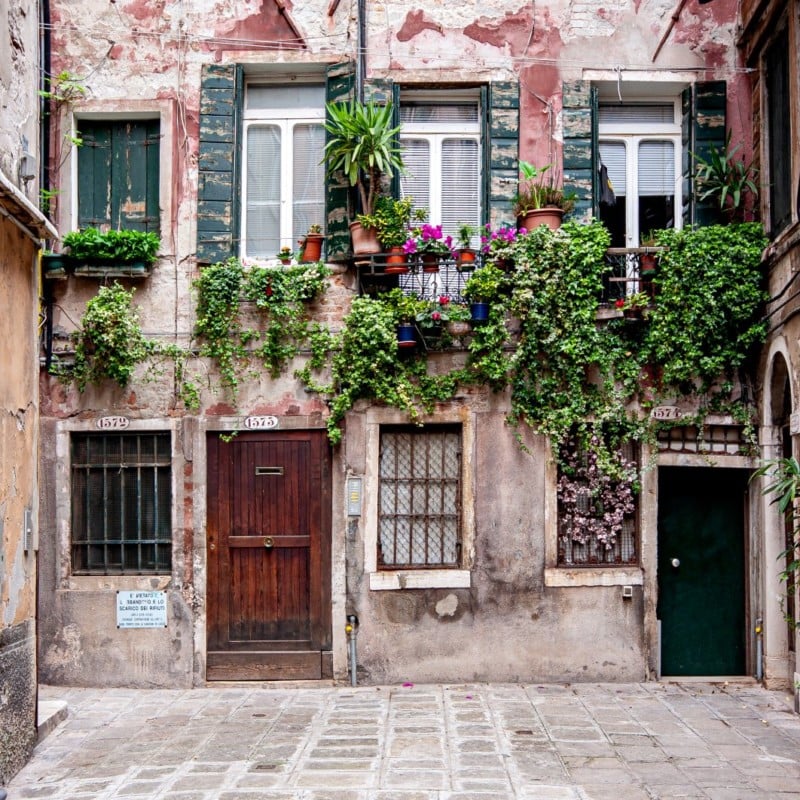
Streetscapes are actually much easier to capture in flat light. Take a look at the two photos on the next page. They were both taken on Temple Lane in Dublin. In the first one, the light was too strong leaving one side of the street in deep shadow. In the second one, the overcast light allowed me to capture all of the detail in the scene.
![]()
This version has plenty of exposure problems with clipped shadows and blown highlights.
![]()
The flat light allows all the detail to be captured.
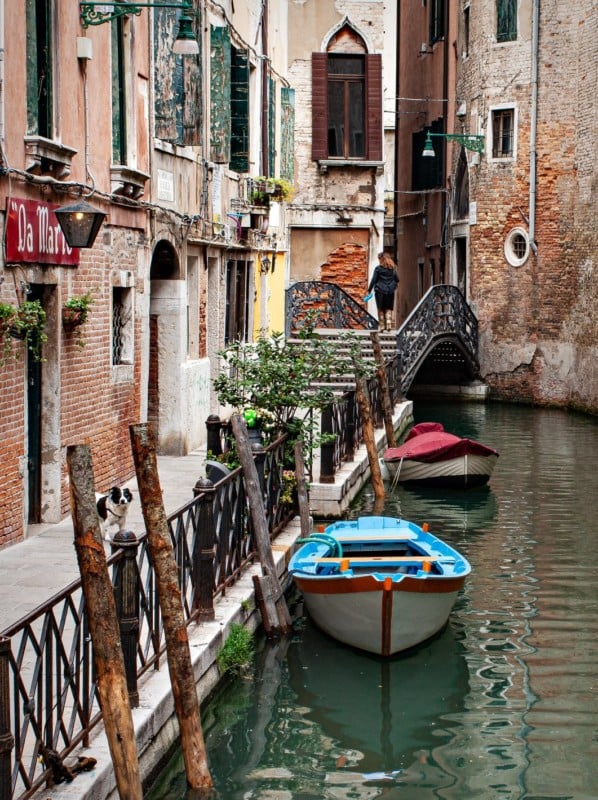
There is plenty of detail in all of the textures in this Venetian streetscape thanks to the even light.
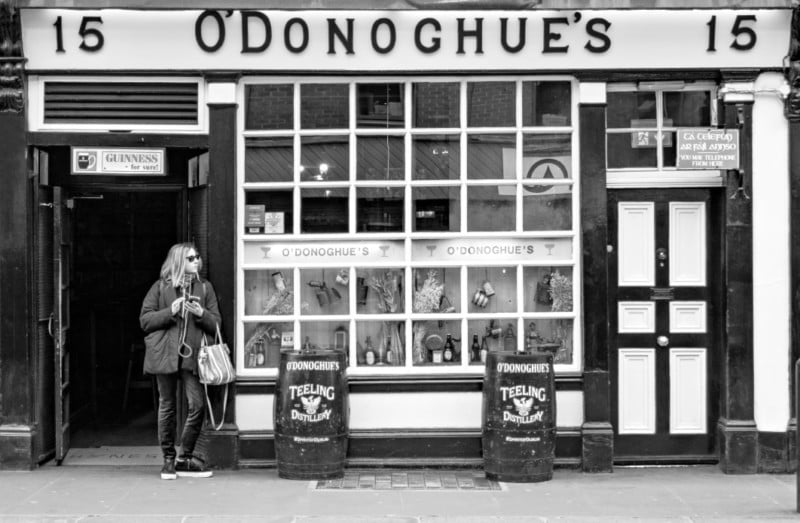
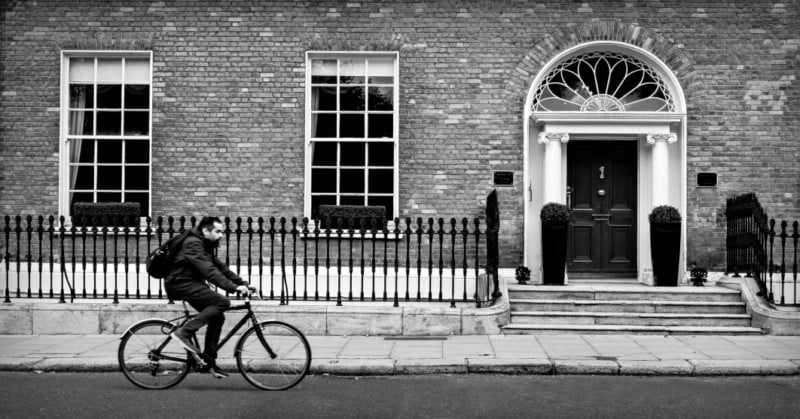
Black and white street photography is also a great option for overcast days.
Wildlife Photography
The flat light of a cloudy day is ideal for wildlife photography. Once again, the light on such days lights the scene very evenly, making it possible to capture plenty of detail. As with street photography, you can concentrate your efforts on your subject matter rather than fiddling with exposure settings.
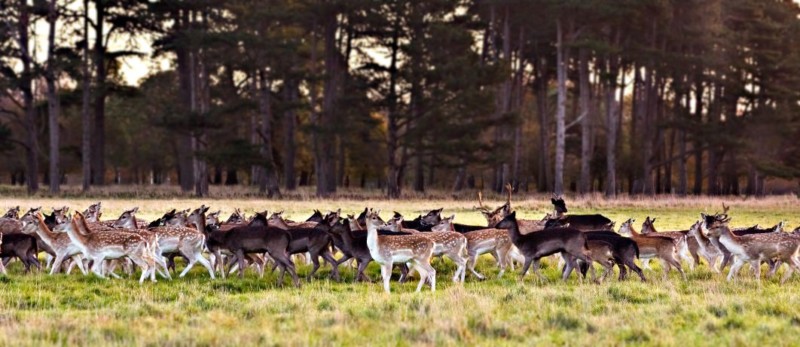
I rarely photograph wildlife but I was lucky to be there when this herd of deer crossed the Phoenix Park in Dublin. One deer suddenly stopped and looked back, possibly remembering he’d forgotten to turn off the immersion that morning.
Minimalist Style Photography
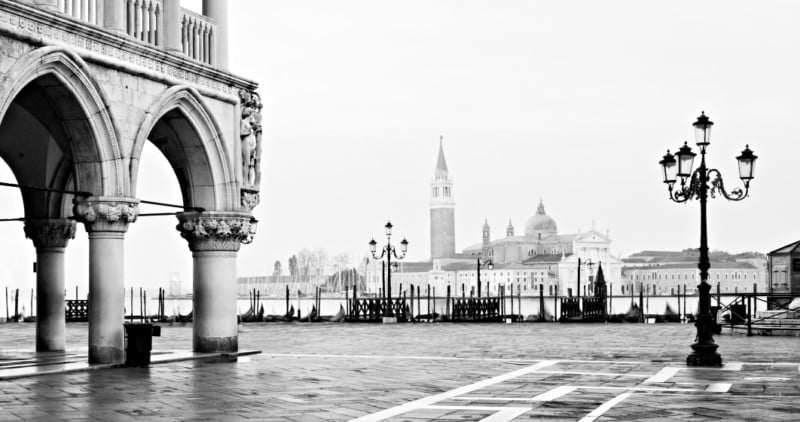
Featureless overcast skies are perfect for photographers who prefer a more minimalist feel to their images. The lack of detail in the sky above focuses the viewer on the street lamp and the church of San Giorgio in the distance.
I’ve become increasingly interested in this more minimalist style of photography recently. Most of my photos feature plenty of detail and bold colors. It’s nice to try something different every so often and move out of your comfort zone.
Conclusion
I hope this tutorial has given you some ideas of what to photograph during the morning and midday light.
This tutorial is an excerpt from an eBook I wrote on photography, titled Outdoor Photography Essentials, which contains more information on light including evening light and challenging lighting conditions. The other sections of the book cover exposure, camera settings, and composition.
The book was laid out specifically to be read on a Kindle, tablet, or mobile phone. Many books convert very awkwardly to this format so great care was made to make the layout clear and easy to follow on digital devices.
Outdoor Photography Essentials can be purchased from Amazon Kindle Store for $7.99 although it is completely free through 6/20/20.
About the author: Barry O Carroll is a Dublin, Ireland-based photographer specializing in landscape photography with a particular emphasis on urban landscapes, street scenes and architecture photography. You can find more of his work on his website and blog or by following him on Instagram.